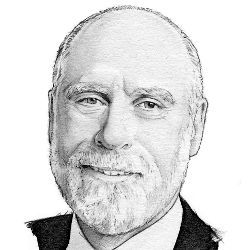
I have just returned from the Third Heidelberg Laureate Foruma and it equaled and perhaps outperformed the previous two. It was also, however, a poignant event because we were reminded of the ephemeral nature of our human lives. The instigator and patron of these conferences, Klaus Tschira, passed away unexpectedly in March 2015. His enthusiasm, curiosity, and capacity for making things happen were greatly missed, but his spirit lives on in the leadership and staff of his foundations. They showed renewed commitment to Klaus’ vision, warmth, and generosity in the conduct of this extraordinary gathering.
A new element was introduced this year: a truly inspiring lecture by Nobel Prize winner Stefan W. Hell on the development of super-resolved fluorescence microscopy. Combining stunningly clear, animated, technical slides with his personal story, Stefan told of a compelling and dramatic odyssey toward a brilliant insight into the improved resolution of optical microscopy. Each future Heidelberg Laureate Forum will feature the "Lindau Lecture" by a Nobel Prize winner. The lecture is named after an annual meetingb of Nobel Prize winners and 600 students that has been held since 1951 in Lindau, Germany. It is now also planned that at each Lindau meeting, there will be a "Heidelberg Lecture" by one of the Heidelberg laureates. This has a personal consequence for me, as I have been invited to make that first lecture in 2016. This is a daunting prospect and I hope I will be up to it!
The lectures were once again thought provoking and stimulated a lot of discussion. There were many poster sessions and workshops that stirred comparable interactions and, as usual, there was ample time for informal discussion among the students and laureates. For me, the opportunity to explore ideas at meal times and on excursions represented a substantial portion of the value of this annual convocation.
Among the excursions was a new one (for me) to the Speyer Technik Museumc led by Gerhard Daum. The museum was originally built to house the Russian BURAN spacecraftd—the counterpart to the U.S. Space Shuttle. Daum, who had been collecting space artifacts since boyhood, brought hundreds of additional artifacts to the museum, including a full-size Lunar Excursion Module in a moon-diorama setting along with the moon rover vehicle and figures in spacesuits. The most surprising artifact was an actual 3.4-billion-year-old moonstone collected during the Apollo 15 mission! The exhibition tells the story of the American, European, and Russian space efforts and includes many original artifacts from each. I spent at least an hour and a half with Daum, whose knowledge of the space programs around the world is encyclopedic in scope and rivaled only by his unbridled enthusiasm for space exploration.
ACM President Alexander Wolf represented ACM ably and eloquently and chaired one of the morning lecture sessions. Many fellow ACM Turing Award recipients were key contributors to the event. Leslie Lamport gave a compelling lecture advocating the use of mathematics in the description of computer systems to aid in their construction and analysis. Manuel Blum brought drama to the stage by demonstrating how he could brief four volunteers on ways to "compute" passwords at need without memorizing them. All four succeeded! Sir Tony Hoare reminded us the roots of computation and science go back to Aristotle and Euclid and other philosophers who have advanced the state of the art over millennia. Edmund Clarke drew our attention to the importance of being able to say something about the correctness of computations dealing with real, continuous quantities ("hybrid systems"). As we enter into a period in which we depend increasingly on cyberphysical systems, such considerations are vital. Ivan Sutherland demonstrated by construction that asynchronous computing is not only feasible but also incredibly fast. Fred Brooks offered a personal history of computing by sharing his experiences with some of the giants in our field—it was as if the pages of a history book opened up. Butler Lampson reminded us there are principles for good system design: STEADY AID: <goals> simple, timely, efficient, adaptable, dependable, yummy and <methods> approximate, increment, iterate, indirect, divide (and conquer). Leonard Adleman led us through a fascinating exploration of Riemannian Surfaces and their properties in algebraic number theory. Peter Naur explored a synapse-state theory of the mind and its associative properties. Andy Yao drew attention to the growing potential of quantum computation. Leslie Valiant pondered when two mathematical functions are the same and used the concept of holographic transformations applied to computational complexity. Surprisingly, Valiant’s talk reignited my personal interest in the graph equivalence problem and I spent several hours exploring this with some students over dinner.
I am looking forward to Heidelberg and Lindau in 2016.



Join the Discussion (0)
Become a Member or Sign In to Post a Comment